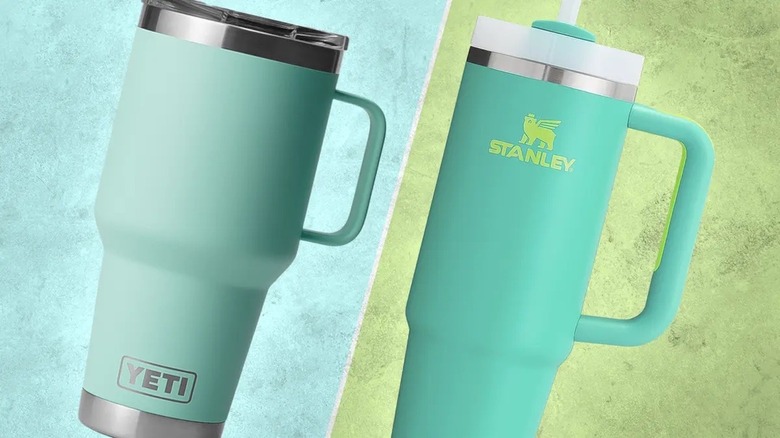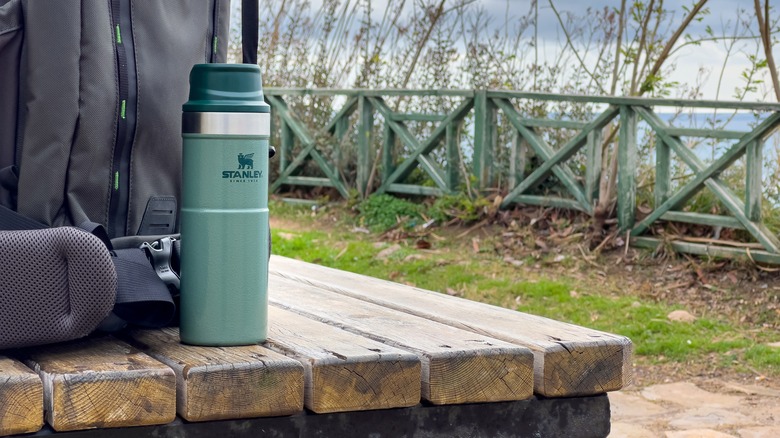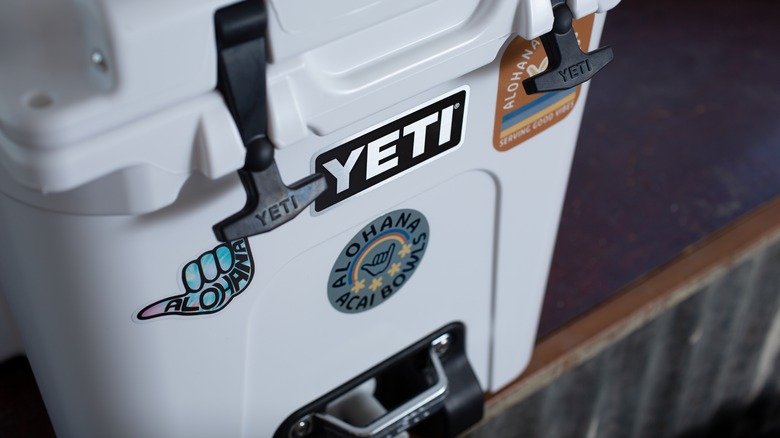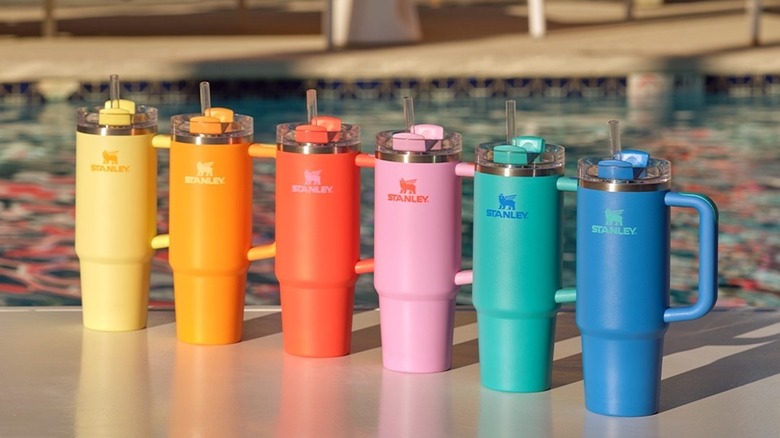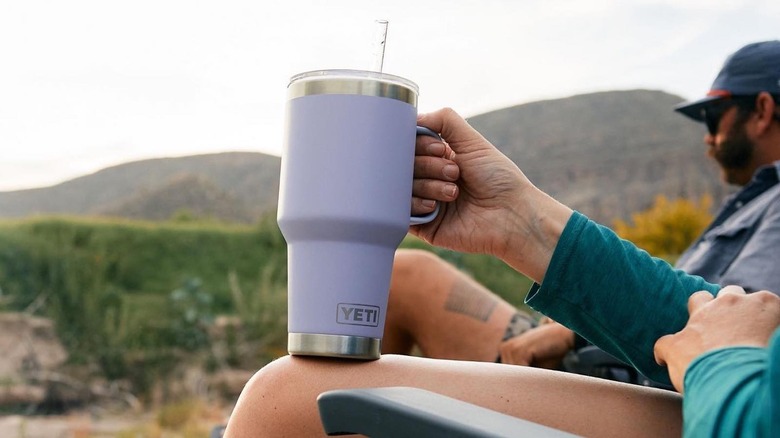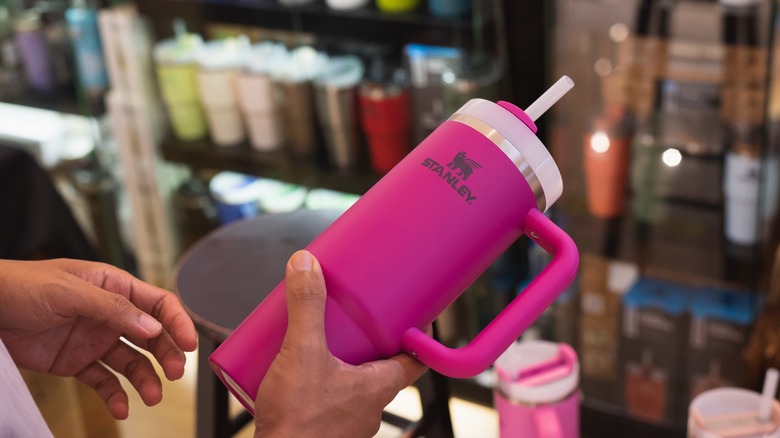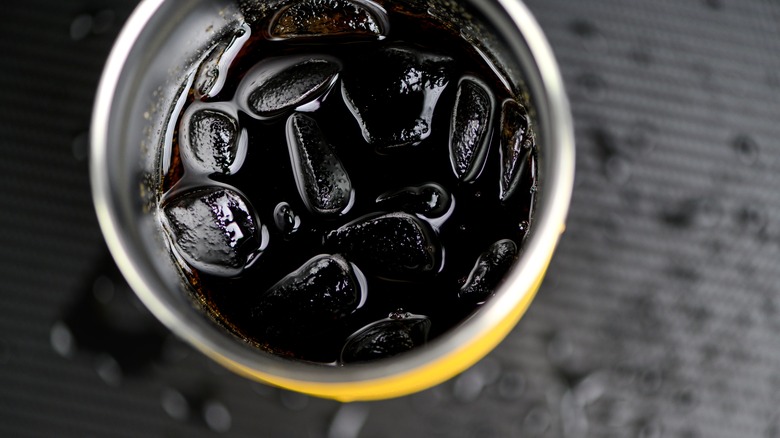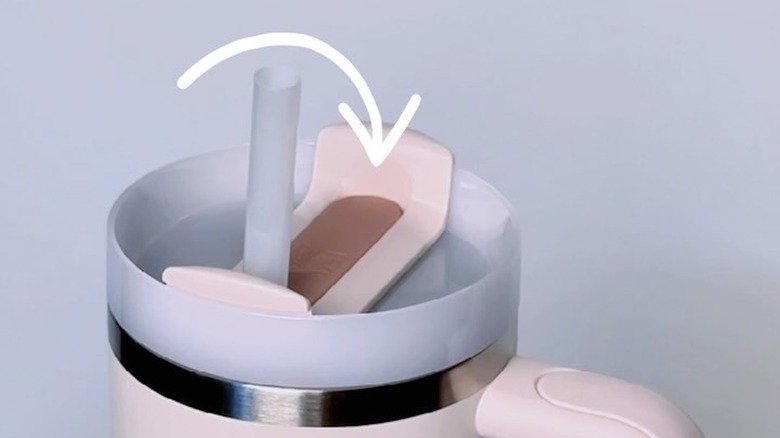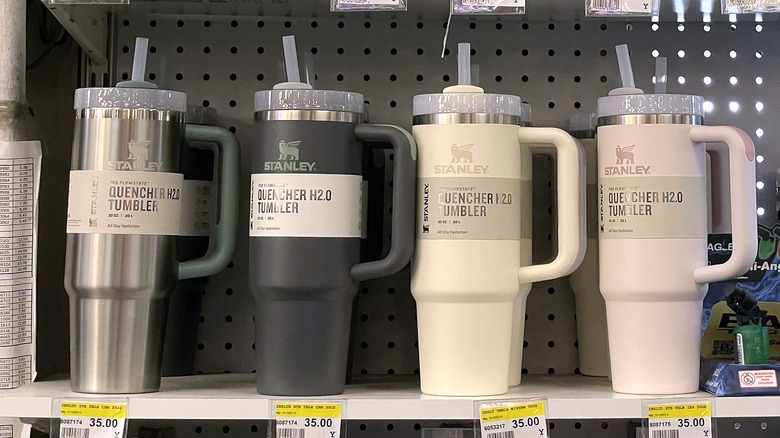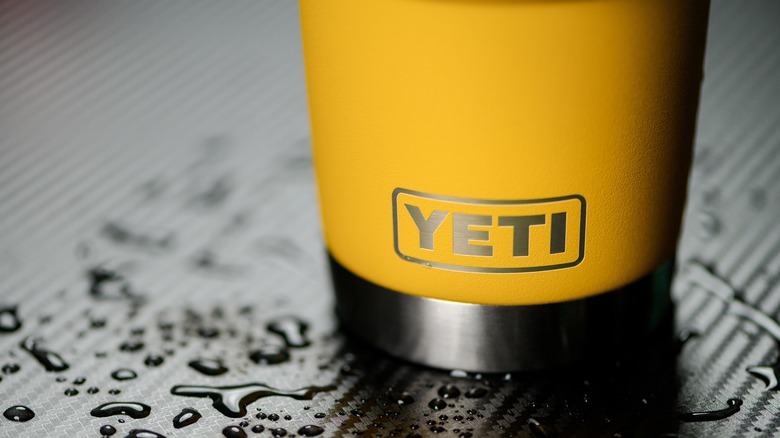The Actual Difference Between Stanley And Yeti Tumblers
Given America's rising fixation on drinking less soda and alcohol, the drink aisle has become the best aisle in the grocery store. It's stocked with more beverage options than ever before — and you have even more options for what to drink them out of, too. On your hunt for a new water bottle, you'll come across many different brands and color schemes. But, these days, the two most prevalent are Stanley Quencher and the Yeti Rambler.
The two insulated water bottles promise to keep your drinks hot for hours and cold for days, and they do so in a similar fashion. Designed to fit within the cup holder of your car, both bottle designs boast a larger top side that taper in towards the bottom. The side handle makes them easy to carry with you everywhere, while the built in straws will keep you sipping water consistently all throughout the day. To the eye, the two water bottles are practically the same.
Looks, however, can be deceiving. While each brand has developed a dedicated consumer base, they do have some key differences that might make one better for you than the other. Should you ever find yourself stuck choosing between the two, you'll find a breakdown on what those are below.
What is Stanley?
While it may have only recently come into the spotlight — mostly due to the virality of the Quencher water bottle, with which the company has done numerous big name collaborations — Stanley was founded over 100 years ago. Inventor William Stanley Jr. created the company in 1913 using a fusion of vacuum insulation and steel to create the iconic (and virtually indestructible) all-steel, vacuum sealed water bottles you all know today. Since then, Stanley has had a fascinating comeback story.
A lot has changed about Stanley in the last 100 years, as you should expect from a brand based on such innovation. Originally created as a way for William Stanley himself to enjoy his coffee, and keep it hot, the bottles became associated with military servicemen, campers, and construction workers. Much of that can be tied to the use of Stanley bottles by pilots serving in WWII. The original military green colorway remains the most recognizable to this day.
It wasn't until 2020, however, that Stanley stepped into a new era — one very different from its macho past. Thanks to the many colorways, sizes, and designs, they're much more popular among young women attending pilates classes than they are among men on the battlefield. Still, that history is something people can appreciate, and it only goes to show how timeless the water bottles truly are.
What is Yeti?
Yeti is a relatively newer name to appear on the water bottle store shelf compared to Stanley. Founded in 2006 by Roy and Ryan Seiders, the company is just under a couple of decades old — but it's managed to build a fast reputation for high-end, quality products with a fascinating history. Given their love for the outdoors, the two Texan brothers had grown disappointed with the outdoor equipment available on the market, particularly with how they performed in their home state's heat. In turn, the brand's legendary Tundra cooler was the first Yeti product hit on the market.
In due time, the brothers would expand the same insulation technology that made their coolers so dependable to other Yeti products — including water bottles. Like Stanley, Yeti offers a number of different water bottle designs, colors, and sizes, all of which promise to last a lifetime and keep your ice cold longer. The Rambler, which comes in three different sizes, is the style that's the most similar to the Stanley Quencher. But, while they might look alike, the two have some differences you should be aware of before you decide which of the two to buy.
Stanley has more color options and sizes, but some go overboard
If you're someone who struggles with being decisive, you won't only be struggling to choose which water bottle to purchase — but which color and size. Both water brands come in a wide variety of colors and sizes, with Stanley offering slightly more than the Yeti. To compare, Stanley Quenchers come in 40 different colors, including special limited edition color ways like the Starbucks x Stanley collab and the red and pink Target Stanleys you can only buy from specific retailers. The Yeti bottles, on the other hand, come in a slightly smaller variety of colors that numbers just over 20.
Given the Yeti's frequent rollout of new on trend color ways, your options are going to be significantly wider. Whether that's a good thing or a bad thing depends on how decisive you are, but there is one more factor you're going to have to contemplate and that's the size of your water bottle. Stanley Quenchers come in five different sizes: 14, 20, 30, 40, and 64 ounces. If you want a straw and a handle, the Yetis deliver in three sizes: 25, 35, and 42 ounces. But, given that the Stanley's largest size is so big it's awkward to hold, and the smaller 14 and 20 ounce sizes don't come with handles, you're most likely going to be choosing between the middle two, anyways.
Yeti handled bottles are both slimmer and lighter but sacrifice comfort
Sizes and colors aside, Yeti Ramblers and Stanley Quenchers are very similar in design — but there are some differences that could make one better for you than the other. While the sizes might be similar, varying by just two to five ounces, the Yeti Ramblers come in a much sleeker profile. This could be appealing, but in retrospect the handles on the side of the Yetis are almost too slender. Some people find them uncomfortable to hold, especially if you have larger hands. It also seems to make them easier to tip over.
On the other hand, the Stanley's bulkier design seems to rule in its favor — particularly as it pertains to the handle on the side of the cup. Compared to the Yeti's, people seem to appreciate its softer texture and larger size. The space between the side handle and the side of the cup provides adequate room to either hold it from the inside, wrapping your hand around the cup, or the outside, holding around the outer side of the handle. All in all, the Stanley is much more comfortable to hold. But things do get a progressively less so when you venture into the larger sizes, making the midsized 30-ounce Quencher the most preferred of all the types of Stanley drinkware.
Stanleys are slightly more prone to spillage
While the odds of spilling your drink definitely come down to your own personal clumsiness, Yeti Ramblers are said to be much less leaky in general. Rather than screwing on and off, the Yeti's top pops in and out, making it far more secure. While designed to be held upright, the Yeti leaks very minimally when turned on its side. Yeti also makes something called a MagSlider Lid, which you can purchase separately, although it doesn't come with a straw and only fits certain sizes and styles of Yeti drinkware. Some of the sizes also come with what Yeti calls a Stronghold Lid, which is also straw-less, but doesn't leak unless the cup is turned completely upside down, and still only minimally.
One of the Stanley's main caveats is that it's prone to leaking. While both of these water bottles are designed to be held upright, and probably shouldn't be thrown into your bag or backpack — sometimes, accidents happen. You might bump it or drop it by mistake, at which time you'll be relieved to find minimal leakage. Stanley Quenchers, however, aren't going to provide you with that. At least, not as well as the Yeti will. Even though they come with a screw on lid and a removable silicone liner that helps prevent leaks, the Stanleys still spill considerably more than the Yeti's do when knocked on their sides.
Both bottles keep things equally cool, but the Stanley locks in more heat
When shopping for an insulated water bottle, one of your primary concerns is likely how efficient it's going to be at keeping your water cold. While you might be hoping you could make a quick decision between the Stanley Quencher and the Yeti Rambler based on that alone, the truth is that these two bottles are equally impressive at keeping cold things cold. Tests have shown the Stanley Quenchers to hold cold temperatures steady for as long as 24 hours, only dropping by as much as a degree, although a dent can easily ruin your cold drinks. The Yeti Ramblers, held up nearly the same way — dropping just one degree more.
Where you will see a slightly greater significance of a difference, on the other hand, is how these two water bottles retain heat. Maybe it's because the Stanley's inventive original purpose was to keep hot coffee hot, but it proved to exceed the Yeti in hot beverage tests by a difference of a few degrees. When kept inside a Stanley, hot beverages retained heat for up to six hours, after which they dropped about 30 degrees. Even so, the beverage was still decently warm after 24 hours. While it may just be a few degrees, if you're planning to drink something like hot tea or bone broth from your bottle, the Stanley might be the one for you.
Yeti lids are more durable, but not as multi-purpose as the Stanley's
While the Stanley lids might spill more than the Yeti ones, they are definitely much more useful. Stanley lids have the option to be a sip top or a straw top, and it's as easy to switch as a quick rotation of the center slab. It also gives you the option to completely close the lid, although it does require you to take the straw out. A Yeti Rambler, on the other hand, will require you to purchase separate lids for different methods of sipping. Yeti offers a number of different lid styles for purchase to fit your Rambler — requiring two lids to pull off what the Stanley Quencher offers in one (although there are Stanley cup accessories, too).
While they typically come with a straw lid, the brand offers the $10 MagSlider Lid for sipping and full closure, and the $13 Stronghold Lid for extra anti-spillage protection. Yeti does, however, offer more lids that turn the product into more than just a water bottle — for instance, you can purchase a French press top. Another thing to consider here, however, is the durability of the lids themselves. Yeti straws are noticeably firmer than those from Stanley, plus they have a built in straw stopper that keeps it from falling out. While they might not be as multi-purposeful, the Yeti lids are also considerably more heavy duty than the Stanley's, even if they do come at an extra price.
Stanley offers larger sizes at a slightly lower price point
Another, be it slightly more obvious, matter to consider when purchasing a new water bottle is how much you're willing to spend. But, the Stanley Quenchers and Yeti Ramblers come in at similar price points. The Yeti Ramblers, for example, sell for $38 for a 25 ounce size, $42 for the 35 ounce size, and $45 for the 42 ounce size. While they do offer free customization, the most popular Stanley Quencher 30 ounce size sells for a few dollars less, with a regular price tag of $35. But, don't forget, you'll also be paying more for a Yeti if you want a spill-proof lid — with both hovering between an additional $10 to $13.
Stanley might not offer you the option to customize your Stanley Quencher, but, as mentioned above, they do offer many more trendy colors. Looks aren't the only thing to consider when making a water bottle purchase, however. This very article is an example of that. So, while you might be paying less for a Stanley and getting all lid styles in one, keep in mind that they aren't quite as durable nor as leak-proof as the Yeti Ramblers are — the brand also confirmed they contain lead. A bigger size like the 40 ounce, and 64 ounce Stanley size will also end up costing you as much or more than a Yeti would, but could be worth it if you want to have more water on hand.
Both are dishwasher safe, with the Yeti less prone to chipping
A major pro to look out for when it comes to buying a new water bottle is whether or not any one you're looking at dishwasher safe. Fortunately, both the Yeti Ramblers and Stanley Quenchers are — although Yeti does specify you should keep the lid on the top rack and the straw in the utensil basket. That alone makes the task of cleaning your water bottle everyday much easier, which is important, seeing as how surprisingly dirty they can get. But, just because something is dishwasher safe doesn't mean it will hold up to consistent, long-term, daily dishwasher cleaning. At least, not as it pertains to the Stanleys.
Your water bottle can go through a lot of wear and tear in the dishwasher. Even though that shouldn't be a problem for an all steel, military grade, vacuum sealed water bottle like the Stanley, this is an area where the Yeti's durability proves to be superb. People have reported that their Stanley water bottles are left with scratches and chips on the cups colored areas after them after consistent cleaning in the dishwasher — in some cases after as little as three months.
Yeti's water bottles, on the other hand, stand up well to the dishwasher without any reports of chipping or scratching. Although this can easily be avoided by hand washing your Stanley, there's no arguing the convenience that the dishwasher allows.
